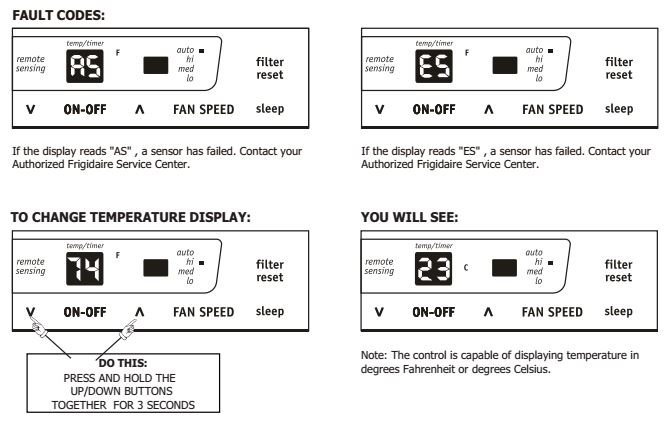
The “OE” error code in Frigidaire air conditioners typically indicates an issue with the water drainage system. Your air conditioner is telling you that there’s something amiss with how it’s handling all the condensation it collects. Much like how our sweat evaporates to cool us down, air conditioners collect moisture from the air and need to drain it out to keep functioning smoothly. If something goes wrong with this process, you’re likely to see that pesky “OE” code.
Understanding the OE Error Code
To unravel the mystery of the “OE” error, let’s delve a little deeper. The “OE” code usually pops up when the unit’s drainage system backs up. Think of it like a kitchen sink. Just as debris can clog your sink, causing water to stagnate rather than flow away, your air conditioner’s drainage system can get blocked. Over time, dust, dirt, and even small insects can find their way into the drainage tube.
When the drainage system is obstructed, the moisture isn’t expelled properly and gets stuck. This not only affects the cooling efficiency but can also lead to water leaking from the unit—a real inconvenience. If left unattended, it might even lead to more severe issues down the line. Fortunately, understanding this process is the first step in preventing the issue from recurring. By keeping the drainage system clean and ensuring it’s free from blockages, you can save yourself from repeated frustrations.
Regular Maintenance: Your Best Preventative Measure
So, how can you avoid seeing that pesky error code next time you’re trying to relax in the cool air? The secret lies in regular maintenance. Just like a car needs periodic oil changes and tire rotations, your air conditioner thrives on routine care. The most straightforward way to start is by regularly checking and cleaning the drainage system.
Begin by inspecting the drain pan and the hose connected to it. These can be easily cleaned with a bit of mild soap and warm water. Use a soft brush or cloth to gently scrub away any grime. Imagine it as giving your air conditioner a refreshing shower to wash away the dirt. Also, make it a habit to check for cracks or signs of wear in the drainage hose, as these can lead to leaks or blockages if left untreated.
In addition to cleaning, ensuring your unit is level can make a difference. If it’s tilted, gravity might not be able to help the water flow where it needs to go. Keep the area around your air conditioner free from clutter that might obstruct airflow and thus prevent efficient condensation drainage. By integrating these simple maintenance tasks into your routine, you can effectively manage and reduce the chances of encountering the “OE” error code.
The Importance of Location and Positioning
The location of your air conditioner can play a critical role in its performance and the likelihood of encountering error codes. For instance, if your unit is installed in a location that’s prone to dust or near plants shedding leaves, it may be more susceptible to blockages. Just as we wouldn’t put ice cream in direct sunlight and expect it to stay frozen, situating your air conditioner in an advantageous spot is crucial for optimum performance.
Ideally, place your unit in a way that minimizes exposure to excessive dust and debris. Make sure it’s installed on a stable, even surface to ensure proper drainage. If the air conditioner shakes or vibrates more than usual, it might disrupt the way water is channeled out, potentially leading to drainage problems.
Positioning also involves thinking about the airflow. If the unit is crammed into a tight space without enough room to breathe, it’s akin to trying to run a marathon while wearing a scarf over your mouth. Ensuring adequate space around the unit allows it to draw in air efficiently and expel condensate without hindrance. By considering these positioning tips, you minimize the risk of error codes and enhance your unit’s overall longevity.
Additional Tips for Seamless Performance
Beyond the obvious maintenance and positioning strategies, there are a few more tricks up the sleeve to keep that “OE” error at bay. Always ensure that the air filters are clean. Much like how a vacuum cleaner loses its efficacy with a full bag, an air conditioner struggles when its filters are clogged. Regularly replacing or washing your filters ensures they can trap dust and allergens effectively, keeping the internal components of your unit cleaner.
Moreover, during periods of inactivity, like the winter months, consider covering your air conditioner. This simple action prevents dust and debris from settling within the unit, making the spring cleaning much easier and ensuring top performance when it’s time to turn it back on.
Finally, if all else fails and you’re still facing issues, don’t hesitate to call in a professional. Air conditioning techs are like the detectives of the HVAC world, adept at diagnosing and fixing problems you might overlook. By keeping these additional tips in mind, you not only prevent error codes but also promote the overall efficiency and lifespan of your air conditioner.
Hopefully, with these insights and actions, you can enjoy a cool, worry-free environment without the fear of unexpected interruptions. Remember, consistency is key, so stay proactive with your maintenance routine for the best results.